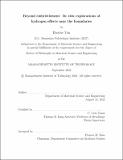Beyond Embrittlement: In-Situ Explorations of Hydrogen Effects Near the Boundaries
Author(s)
Yan, Haoxue
DownloadThesis PDF (33.74Mb)
Advisor
Tasan, C. Cem
Terms of use
Metadata
Show full item recordAbstract
Despite tremendous research efforts in the past decades, hydrogen embrittlement (HE) still limits the use of structural metals in hydrogen environments today. As the demand for hydrogen clean energy equipment increases, it is ever so pressing for us to extend our understandings of embrittlement mechanisms. The discourse in the current proposed HE mechanisms arises from the dependencies of hydrogen effects on microstructure factors as well as the difficulties in directly detecting hydrogen behaviors. This thesis first designs in situ experiments that combine different scanning electron microscopy based characterization capabilities with hydrogen charging and detection methods to set correlation between local hydrogen distribution, microstructure, and defect activities. With these new techniques, we pay special focus to the dependencies of hydrogen effects on boundaries and the crystalline structures of the two adjoining grains. We hypothesize that hydrogen preferentially distribute near boundaries, and this behavior is dependent on neighboring crystalline structures. As a result, the stress variations caused by boundary segregation lead to defect activities which diminishes with hydrogen content. It is also hypothesized that the presence of boundaries, especially those that act as deep trap sites, will lead to complex phase transformation pathways and hydrogen evolution throughout. To this end, we first present experimental findings as well as quantitative assessments of hydrogen-defect interactions as a result of hydrogen segregation. A microstructure-design based approach to increase HE resistance was also proposed. We then study the role of phase boundaries during hydride decomposition and reformation and discuss the effectiveness of thermal treatments as an effective method for preventing HE. Lastly, utilizing our understanding of hydrogen preferential distribution and its effects on defect behaviors, we propose a new engineering approach to utilize hydrogen in microstructure control.
Date issued
2022-09Department
Massachusetts Institute of Technology. Department of Materials Science and EngineeringPublisher
Massachusetts Institute of Technology